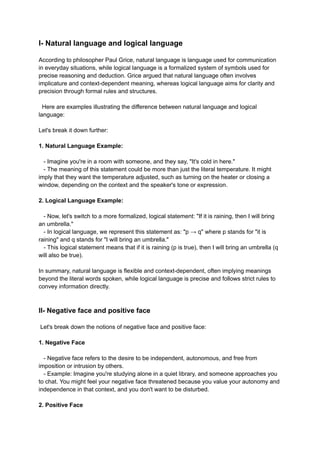
Pragmatics:Natural and logical lan-2.pdf
- 1. I- Natural language and logical language According to philosopher Paul Grice, natural language is language used for communication in everyday situations, while logical language is a formalized system of symbols used for precise reasoning and deduction. Grice argued that natural language often involves implicature and context-dependent meaning, whereas logical language aims for clarity and precision through formal rules and structures. Here are examples illustrating the difference between natural language and logical language: Let's break it down further: 1. Natural Language Example: - Imagine you're in a room with someone, and they say, "It's cold in here." - The meaning of this statement could be more than just the literal temperature. It might imply that they want the temperature adjusted, such as turning on the heater or closing a window, depending on the context and the speaker's tone or expression. 2. Logical Language Example: - Now, let's switch to a more formalized, logical statement: "If it is raining, then I will bring an umbrella." - In logical language, we represent this statement as: "p → q" where p stands for "it is raining" and q stands for "I will bring an umbrella." - This logical statement means that if it is raining (p is true), then I will bring an umbrella (q will also be true). In summary, natural language is flexible and context-dependent, often implying meanings beyond the literal words spoken, while logical language is precise and follows strict rules to convey information directly. II- Negative face and positive face Let's break down the notions of negative face and positive face: 1. Negative Face - Negative face refers to the desire to be independent, autonomous, and free from imposition or intrusion by others. - Example: Imagine you're studying alone in a quiet library, and someone approaches you to chat. You might feel your negative face threatened because you value your autonomy and independence in that context, and you don't want to be disturbed. 2. Positive Face
- 2. - Positive face refers to the desire to be liked, accepted, and approved of by others, as well as to have one's desires and feelings respected. - Example: Consider a group discussion where you propose an idea, and your peers respond positively, acknowledging your contribution and showing interest in your perspective. In this situation, your positive face is supported because you feel valued and respected by the group. In essence, negative face concerns one's need for freedom and autonomy, while positive face involves the desire for social connection, approval, and affirmation from others. These concepts are crucial in understanding how individuals manage their interactions and maintain harmony in social relationships. III- Positive politeness and positive impoliteness Let's break down the notions of positive politeness and positive impoliteness: 1. Positive Politeness - Positive politeness involves strategies used to show friendliness, solidarity, and empathy towards others, thereby enhancing their positive face. - Example: When greeting a friend, you might use positive politeness by complimenting them ("Hey, you're looking great today!") or expressing interest in their well-being ("How have you been?"). 2. Positive Impoliteness - Positive impoliteness involves strategies used to assert dominance, assertiveness, or disregard for the positive face of others, often to achieve specific goals or express dissatisfaction. - Example: Imagine you're in a meeting where someone keeps interrupting you and talking over you. This behavior can be seen as positive impoliteness because it disregards your positive face, showing a lack of respect for your contribution or perspective. In summary, positive politeness aims to enhance positive face by showing friendliness and empathy, while positive impoliteness involves behaviors that assert dominance or disregard for the positive face of others, often to achieve certain goals or express dissatisfaction. IV- Negative politeness and Negative impoliteness Let's delve into the notions of negative politeness and negative impoliteness: 1. Negative Politeness - Negative politeness involves strategies used to mitigate imposition on others' negative face by showing deference, avoiding intrusiveness, and respecting their autonomy.
- 3. - Example: Suppose you need a favor from a colleague who seems busy. Instead of making a direct request, you might use negative politeness by saying, "I know you're busy, but if you have a moment, could you please help me with this?" 2. Negative Impoliteness - Negative impoliteness involves strategies used to threaten or undermine others' negative face, often through directness, assertiveness, or disregard for their autonomy. - Example: If someone repeatedly interrupts you during a conversation, you might respond with negative impoliteness by saying, "Excuse me, but I was speaking. Please let me finish before you interrupt again." In summary, negative politeness aims to respect others' autonomy and minimize imposition on their negative face, while negative impoliteness involves behaviors that disregard or threaten others' negative face, often through assertiveness or intrusiveness.